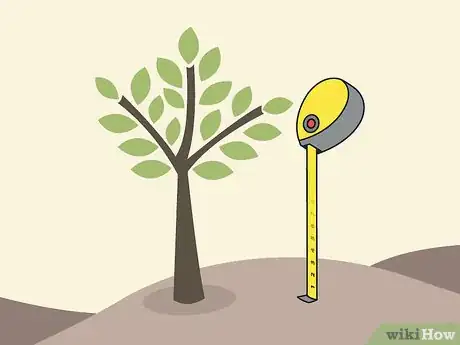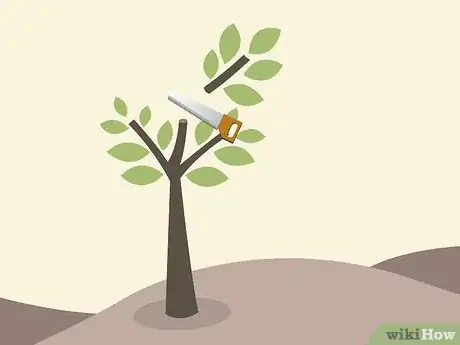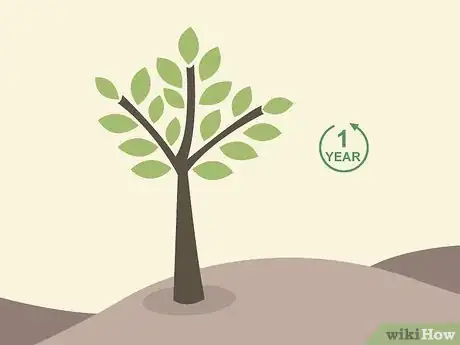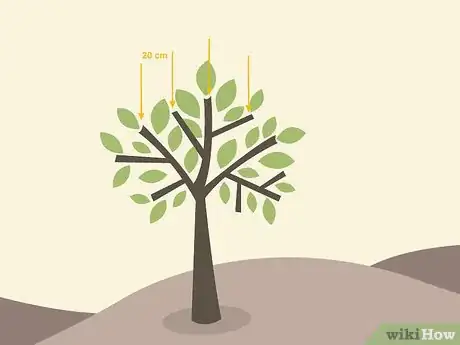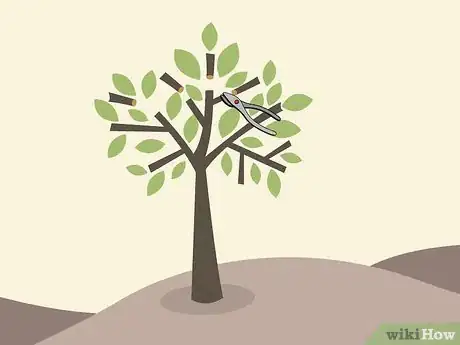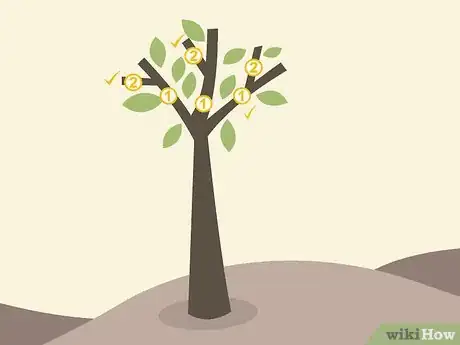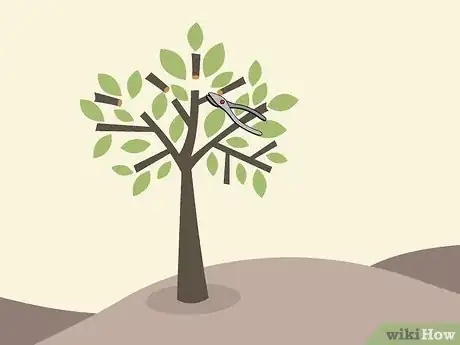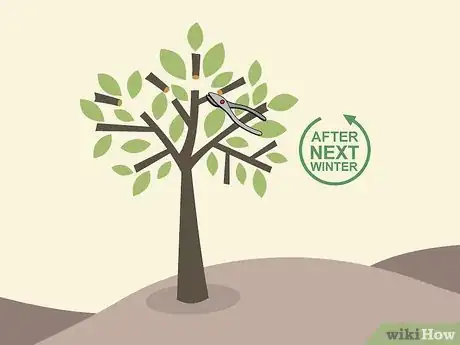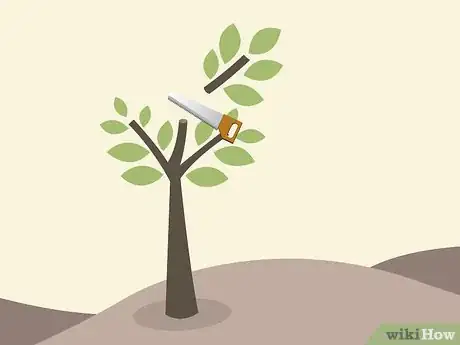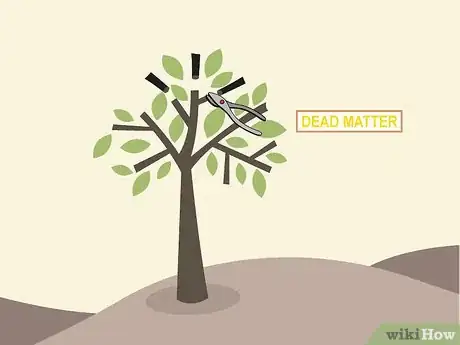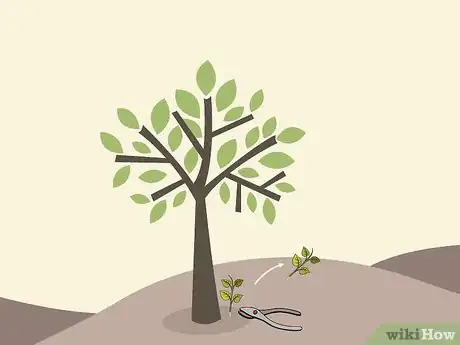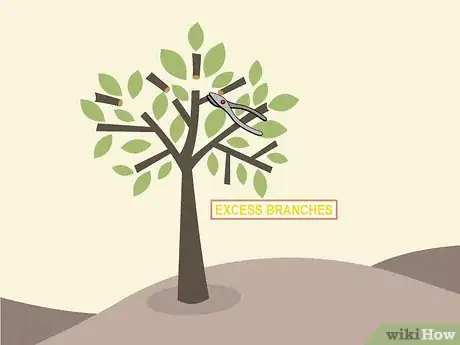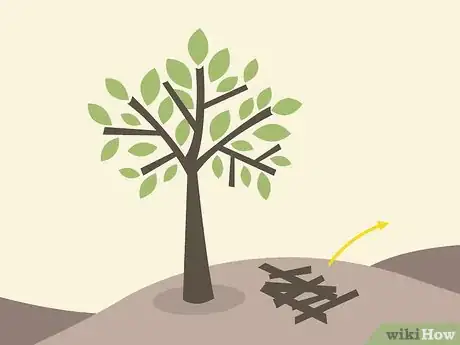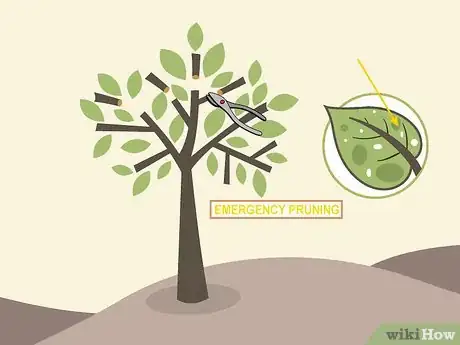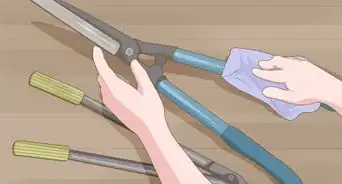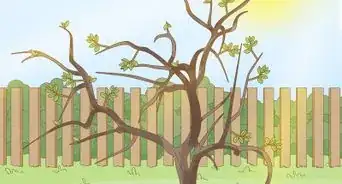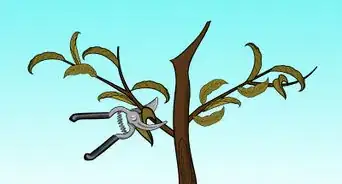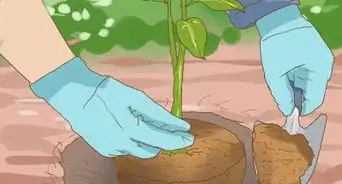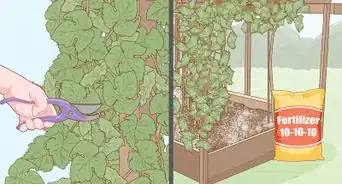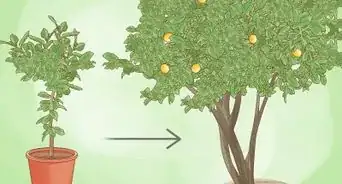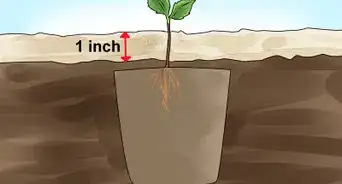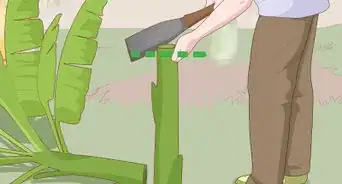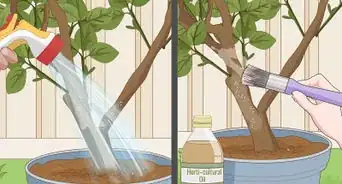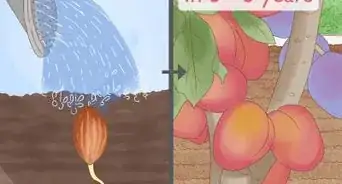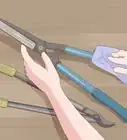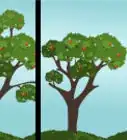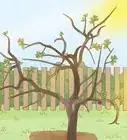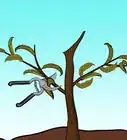This article was co-authored by Maggie Moran. Maggie Moran is a Professional Gardener in Pennsylvania.
There are 7 references cited in this article, which can be found at the bottom of the page.
wikiHow marks an article as reader-approved once it receives enough positive feedback. This article has 28 testimonials from our readers, earning it our reader-approved status.
This article has been viewed 506,361 times.
Pruning a cherry tree is necessary to create the right conditions for the tree to bear beautiful fruit year after year. Young cherry trees should be pruned into a vase-like shape to allow light and air to circulate around the tree's branches. As the tree matures, old branches and dead leaves must also be pruned. By heading your young tree, creating a scaffold whorl, and continuing to prune your tree as it matures, you can promote the trees growth and overall health.
Steps
Heading Your Tree
-
1Sterilize and sharpen your pruning shears. Using dirty, dull pruning shears to make cuts on a tree leaves it prone to disease. Make a solution of 1 part bleach to 9 parts water. Dip your shears in the solution and rinse them off with hot water. Once your shears are sterilized, dry them off with a clean towel. [1]
- It might take a few extra minutes, but it's worth it to ensure your tree won't be harmed by the pruning process.
- Make sure your shears are sharp, so that they don't damage the wood on your cherry tree.
- Sterilize your pruning shears every time you prune your tree.
-
2Measure your cherry tree. Before you prune the tree, measure it with measuring tape or a yardstick to see if it's tall enough. If the sapling is short, wait until it's well over 30 inches (76.2 cm) before inches before heading it. Waiting until the tree is more established before you cut the top will ensure that the cut won't weaken the tree.Advertisement
-
3Cut the top of the central trunk in the fall or winter. Cutting the top of the tree is called heading. Use your sharpened shears to cut the tree with your to 24 to 36 inches (61.0 to 91.4 cm) in height, on a 45-degree angle. Heading the tree will reduce the potential for disease and rot. Do this within the first year or two of planting the tree so you can control the shape the tree takes as it grows.[2]
- If you wait until spring, the tree will have developed buds and the energy that went into bud formation gets wasted.
- Making the cut before buds have formed allows the tree to use that energy to produce healthy branches.
Creating a Scaffold Whorl
-
1Wait a year before pruning a scaffold. A scaffold whorl is a set of 4 lateral branches that extend from the tree. This shape of branches provides structure and keeps the tree's shape balanced. In order to promote healthy growth in your tree, you must promote it's growth in this way. However, do not attempt this too early or you may hurt your young cherry tree. After a year has passed, you can take the steps to create a scaffold whorl.
-
2Choose 4-5 branches spaced 8 inches (20.32 cm) apart. Find four to five branches that will form your scaffold whorl. Branches growing at a 45 to 60-degree angle to the cherry tree make the best branches. Find the healthiest looking branches that are growing from the main tree and use them to create your scaffold whorl. The lowest branch should be branch about 18 inches (45.7 cm) above the ground.[3]
-
3Cut each of the four to five branches back to 24 inches (61.0 cm). Make angled cuts 1⁄4 inch (0.6 cm) above the buds on the four branches that you chose earlier. New growth will emerge where you make the cuts. Dispose of the cut branches in the waste bin.
-
4Keep two secondary branches on each branch on your scaffold whorl . Look for two well-spaced, strong secondary branches to keep on each of the 4-5 branches that you just cut. Cut back the remaining branches flush with the base of the branch, leaving the two strongest branches remaining on each piece of your scaffold whorl. This will help the tree focus its energy on the branches that remain and produce a greater concentration of fruit.
-
5Prune away the remaining branches. Make clean cuts flush against the main tree, so that only the branches that are part of the scaffold whorl remain. Any leftover branches excluding the main branches should be cut off.
-
6Create a second scaffold whorl the following winter. After another season of growth, the tree will be taller with more branches. Assess the tree and determine which branches you want to keep to create a second scaffold whorl about two feet higher than the first one.[4]
- Choose branches that don't fall directly over the older primary branches. Create a scaffolded shape so that sunlight can reach all of the branches of the tree.
Pruning a Mature Tree
-
1Trim new vertical branches. After the third year, it is no longer necessary to create new scaffold whorls. Outward-growing branches bear more fruit than upright branches. To get the maximum amount of fruit out of your tree, you might consider tying a string to the branches in the scaffold whorl and staking them in the ground during the growing season. Doing this will force the branches in the whorl to grow outward instead of vertically.[5]
- Loppers and pruning saws are suitable pruning tools for trees that are too thick to handle with pruning shears. Be sure your tools are sharp and clean before you use them.
-
2Trim dead matter while the tree is dormant. No matter how old the tree is, always try to prune during the winter, while it's still dormant. Trim away any dead or dried branches, dead leaves, and dead fruit. Throw them in the compost heap or garbage.
- Always remember to sterilize your pruning shears before using them, even if you're just cutting away a few dead branches.
-
3Cut back new shoots and seedlings. If you see shoots growing at the base of the cherry tree, cut them. Pull out seedlings as well, so that the cherry tree's roots don't have to compete with a new tree.[6]
-
4Prune any excess branches. Each season, step back and look at your cherry tree is growing properly. Prune new branches that aren't part of the scaffold whorls, as well as branches that cross over one another. Remember that the goal is to create an open shape so that sunlight and air can reach the middle of the tree to help it bear fruit.
- If you see crossed branches, choose one to remove.
- Branches that don't produce fruit can be cut back flush with the leader.
-
5Clean up all cut branches and trimmings. Cherry trees are quite prone to disease, so it's best to remove all the trimmings after you're finished pruning, especially if you pruned away dead branches. Pick the dead matter off the ground and make sure to dispose of them far away from the tree to prevent disease.[7]
-
6Do an emergency pruning if necessary. You might come upon a diseased or dying branch during the spring or summer, the least ideal time to prune a cherry tree. If this happens, prune away the branch, even though the tree is not dormant. The disease might spread to other parts of the tree if you don't remove it right away.[8]
- If you're working with a diseased tree, you should clean the pruning tools you're using between every cut. Dip them in a bleach solution, wash them with hot water, and dry them off before proceeding.
- After you make a cut, cover the exposed cut with salve to protect it.
Expert Q&A
Did you know you can get expert answers for this article?
Unlock expert answers by supporting wikiHow
-
QuestionCan you cut back a cherry tree?
 Lauren KurtzLauren Kurtz is a Naturalist and Horticultural Specialist. Lauren has worked for Aurora, Colorado managing the Water-Wise Garden at Aurora Municipal Center for the Water Conservation Department. She earned a BA in Environmental and Sustainability Studies from Western Michigan University in 2014.
Lauren KurtzLauren Kurtz is a Naturalist and Horticultural Specialist. Lauren has worked for Aurora, Colorado managing the Water-Wise Garden at Aurora Municipal Center for the Water Conservation Department. She earned a BA in Environmental and Sustainability Studies from Western Michigan University in 2014.
Professional Gardener
-
QuestionWhen should you prune a cherry tree?
 Lauren KurtzLauren Kurtz is a Naturalist and Horticultural Specialist. Lauren has worked for Aurora, Colorado managing the Water-Wise Garden at Aurora Municipal Center for the Water Conservation Department. She earned a BA in Environmental and Sustainability Studies from Western Michigan University in 2014.
Lauren KurtzLauren Kurtz is a Naturalist and Horticultural Specialist. Lauren has worked for Aurora, Colorado managing the Water-Wise Garden at Aurora Municipal Center for the Water Conservation Department. She earned a BA in Environmental and Sustainability Studies from Western Michigan University in 2014.
Professional Gardener
-
QuestionCan you prune a flowering cherry tree?
 Lauren KurtzLauren Kurtz is a Naturalist and Horticultural Specialist. Lauren has worked for Aurora, Colorado managing the Water-Wise Garden at Aurora Municipal Center for the Water Conservation Department. She earned a BA in Environmental and Sustainability Studies from Western Michigan University in 2014.
Lauren KurtzLauren Kurtz is a Naturalist and Horticultural Specialist. Lauren has worked for Aurora, Colorado managing the Water-Wise Garden at Aurora Municipal Center for the Water Conservation Department. She earned a BA in Environmental and Sustainability Studies from Western Michigan University in 2014.
Professional Gardener
Warnings
- Do not prune a cherry tree until it has produced fruit for the season. Otherwise, you may not have cherries until the following year.⧼thumbs_response⧽
- Do not prune cherry trees in damp conditions. Cherry trees are prone to diseases that are caused by fungal infections and are more likely to get them when branches are cut and exposed to damp or moist environments.⧼thumbs_response⧽
Things You'll Need
- Pruning shears
- Disinfectants, such as rubbing alcohol or bleach
- Cloth
- Non-asphalt based pruning paste (optional)
References
- ↑ http://baker.ifas.ufl.edu/Horticulture/documents/DisinfectingPruningTools.pdf
- ↑ https://content.ces.ncsu.edu/extension-gardener-handbook/15-tree-fruit-and-nuts
- ↑ https://content.ces.ncsu.edu/extension-gardener-handbook/15-tree-fruit-and-nuts
- ↑ http://www.naturehills.com/about-garden-plants/pruning-cherry-tree
- ↑ http://modernfarmer.com/2015/02/right-cut/
- ↑ https://www.rhs.org.uk/advice/profile?PID=260
- ↑ http://www.swansonsnursery.com/cherry-tree-care/
- ↑ http://www.homeadvisor.com/cost/lawn-and-garden/maintain-trees-and-shrubs/
About This Article
Before pruning your cherry tree, measure it and only prune it if it is taller than 30 inches. To head the tree, diagonally cut off the top so the tree is between 24 to 36 inches tall as this will help prevent rot. Wait at least a year before pruning a scaffold whorl, which is 4 branches extending from the tree. When it's time to prune the whorl, cut the 4 branches back to 24 inches in length and leave 2 smaller branches on each of the 4 main branches. As the tree grows, create a second scaffold whorl a year later. For more tips from our Horticulturist reviewer, including how to create a scaffold so your cherry tree grows healthily, read on!

